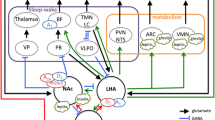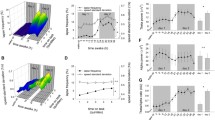Abstract
Alterations of peripheral magnesium (Mg) concentration have been reported in association with several behavioral disorders and sleep organization. Blood Mg regulation is under a strong genetic control, whereas brain Mg regulation does not seem to be affected. We have studied peripheral and central levels of Mg and analyzed sleep in two lines of mice selected for low (MGL) and high (MGH) red blood cell (RBC) Mg levels. The same variables were also studied in C57BL/6J mice before and after 3 weeks of Mg deficiency. Whereas blood Mg was highly affected by the selection, brain Mg exhibited only small differences between the two lines. In contrast, Mg deficiency strongly decreased both central and peripheral Mg levels. Sleep analysis indicated that in both models the amount of paradoxical sleep was lower in mice with higher Mg levels. The amplitude of daily variation in sleep and slow-wave sleep delta power was markedly decreased in MGH line. Quantitative electroencephalogram (EEG) analysis also revealed a faster theta peak frequency in MGH mice, irrespective of behavioral states. Central Mg showed significant correlations with the amount of paradoxical sleep and sleep consolidation. However, because the direction of these correlations was not consistent, it is concluded that optimal, (physiological) rather than high or low, Mg levels are needed for normal sleep regulation.
Similar content being viewed by others
REFERENCES
Altura, B. M., Gebrewold, A., Zhang, A., Altura B. T., and Gupta, R. K. (1997). Short-term reduction in dietary intake of magnesium causes deficits in brain intracellular free Mg2+ and [H+]i but not high-energy phosphates as observed by in vivo 31P-NMR. Biochimica. Biophysica. Acta. 1358: 1–5.
Archer, W. H., Emerson, R. L., and Reusach, C. S. (1972). Intra-and extracellular fluid magnesium by atomic absorption spectrophotometry. Clin. Biochem. 5: 159–161.
Aymard, N., Leyris, A., Monier, C., Francès, H., Boulu, R., and Henrotte, J-G. (1995). Brain catecholamines, serotonin and their metabolites in mice selected for low (MGL) and high (MGH) blood magnesium levels. Magnes. Res. 8: 5–9.
Bac, P., Maurois, P., Dupont, C., Pages, N., Stables, J. P., Gressens, P., Evrard, Ph., and Vamecq, J. (1998). Magnesium deficiencydependent audiogenic seizures (MDDASs) in adult mice: A nutritional model for discriminatory screening of anticonvulsant drugs and original assessment of neuroprotection properties. J. Neurosci. 18: 4363–4373.
Belknap, J. K., Berg, J. H., Cocke, R., and Clancy, A. N. (1977). Induction and reversal of the magnesium deficiency syndrome in inbred mice. Exp. Neurol. 57: 506–515.
Boadle-Biber, M. C. (1978). Activation of tryptophan hydroxylase from central serotonergic neurons by calcium and depolarization. Biochem. Pharmacol. 27: 1069–1079.
Boutrel, B., France, B., Hen, R., Hammon, M., and Adrian, J. (1999). Key role of 5-HT1B receptors in the regulation of paradoxical sleep as evidenced in 5-HT1B knock-out mice. J. Neurosci. 19: 3204–3212.
Chollet, D., Franken, P., Raffin, Y., Malafosse, A., Widmer, J., and Tafti, M. (2000a). Blood and brain magnesium in inbred mice and their correlation with sleep quality. Am. J. Physiol. 279: R2173-R2178.
Chollet, D., Steimer, Th., Tafti, M., and Widmer, J. (2000b). Behavioral differences between two lines of mice genetically selected for high (MGH) or low (MGL) blood magnesium levels: Is there a link between magnesium and anxiety or depression? Mag. 2000: 165.
Chuang, H-U., Jan, Y. N., and Jan, L. Y. (1997). Regulation of IRK3 inward rectifier K1 channel by M1 acetylcholine receptor and intracellular magnesium. Cell 89: 1121–1132.
Chutkow, J. G. (1972). Distribution of magnesium and calcium in brains of normal and magnesium-deficient rats. Mayo. Clin. Proc. 47: 647–653.
Chutkow, J. G. (1990). Magnesium and the central nervous system: Metabolism, neurophysiological functions, and clinical disorders. In: Metal Ions in Biological Systems: Compendium on Magnesium and its Role in Biology, Nutrition, and Physiology, H. Sigel and A. Sigel (Eds.), New York: Marcel Dekker, pp. 441–461.
Classen, H. G. (1986). Systemic stress, magnesium status and cardiovascular damage. Magnesium 5: 105–110.
Crochet, S., and Sakai, K. (1999). Effects of microdialysis application of monoamines on the EEG and behavioral states in the cat mesopontine tegmentum. Eur. J. Neurosci. 11: 3738–3752.
Darlu, P., Rao, D. C., Henrotte, J-G., and Lalouel, J-M. (1982). Genetic regulation of plasma and red blood cell magnesium concentrations in man: I. Univariate and bivariate path analyses. Am. J. Hum. Genet. 34: 874–887.
Depoorter, H., Françon, D., and Llopis, J. (1993). Effects of magnesium-deficient diet on sleep organization in rats. Neuropsychobiology 24: 237–245.
Dralle, D., and Bödeker, R. H. (1980). Serum magnesium level and sleep behavior of newborn infants. Eur. J. Pediat. 134: 239–243.
Feillet-Coudray, C., Mazur, A., Coudray, C., Henrotte, J-G., and Rayssiguier, Y. (2000). Magnesium status evaluation in mice selected for high and low erythrocyte magnesium levels. Mag. 2000: 58.
Franken, P., Malafosse, A., and Tafti, M. (1998). Genetic variation in EEG activity during sleep in inbred mice. Am. J. Physiol. 275: R1127-R1137.
Franken, P., Malafosse, A., and Tafti, M. (1999). Genetic determinants of sleep regulation in inbred mice. Sleep 22: 155–169.
Franken, P., Chollet, D., and Tafti, M. (2001). The homeostatic regulation of sleep need is under genetic control. J. Neurosci. 21: 2610–2621.
Franken, P., Lopez-Molina, L., Marcacci, L., Schibler, U., and Tafti, M. (2000). The transcription factor DBP affects circandian sleep consolidation and rhythmic EEG activity. J. Neurosci. 20: 617–625.
Franklin, K. B. J., and Paxinos, G. (1997). The mouse brain in stereotaxic coordinates. New York: Academic Press.
Fujise, H., Cruz, P., Reo, N. V., and Lauf, P. K. (1991). Relationship between total magnesium concentration and free intracellular magnesium in sheep red blood cells. Biochim. Biophys. Acta. 1094: 51–54.
Hallak, M., Berman, R. F., and Irtenkauf, S. M. (1992). Peripheral magnesium sulfate enters the brain and increases the threshold for hippocampal seizures in rats. Am. J. Obstet. Gynecol. 167: 1605–1610.
Hallak, M., Horta, J. W., Custodio, D., and Kruger, M. L. (2000). Magnesium prevents seizure-induced reduction in excitatory amino acid receptor (kainate and alpha-amino-3-hydroxy-5-methylisoxazol-4-propionic acid) binding in pregnant rat brain. Am. J. Obstet. Gynecol. 183: 793–798.
Heffner, T. G., Hartman, J. A., and Seiden, L. S. (1980). A rapid method for the regional dissection of the rat brain. Pharmac. Biochem. Behav. 13: 453–456.
Henrotte, J-G. (1993). Genetic regulation of cellular magnesium content. In Magnesium and the cell, N. J. Birch (Ed.), London: Academic Press, pp. 177–195.
Henrotte, J-G., Colombani, J., Pineau, M., and Dausset, J. (1984). Role of H-2 and non H-2 genes in the control of blood magnesium levels. Immunogenetics 19: 435–448.
Henrotte, J-G., Pla, M., and Dausset, J. (1990). HLA-and H-2-associated variations of intra-and extracellular magnesium content. Proc. Natl. Acad. Sci. USA 87: 1894–1898.
Henrotte, J-G., Aymard, N., Leyris, A., Monier, C., Francès, H., and Boulu, R. (1993). Brain weight and noradrenaline content in mice selected for low (MGL) and high (MGH) blood magnesium. Magnes. Res. 6: 21–24.
Henrotte, J-G., Aymard, N., Allix, M., and Boulu, R. G. (1995). Effect of pyridoxine and magnesium on stress-induced gastric ulcers in mice selected for low or high blood magnesium levels. Ann. Nutr. Metab. 39: 285–290.
Henrotte, J-G., Franck, G., Santarromana, M., Francès, H., Mouton, D., and Motta, R. (1997). Mice selected for low and high blood magnesium levels: A new model for stress studies. Physiol. Behav. 61: 653–658.
Jouvet, M. (1962). Recherches sur les structures nerveuses et les mécanismes responsables des differentes phases du sommeil physiologique. [in French] Arch. Ital. Biol. 100: 125–206.
Kantak, K. M. (1988). Magnesium deficiency alters aggressive behavior and catecholamine function. Behav. Neurosci. 102: 304–311.
Kirov, G. K., and Tsachev, K. N. (1990). Magnesium, schizophrenia and manic-depressive disease. Neuropsychobiology 23: 79–81.
Kuner, T., and Schoepfer, R. (1996). Multiple structural elements determine subunit specificity of Mg21 block in NMDA receptor channels. J. Neurosci. 16: 3549–3558.
Li-Smerin, Y., and Johnson, J. W. (1996a). Effects of intracellular Mg2+ on channel gating and steady-state responses of the NMDA receptor in cultured rat neurons. J. Physiol. (Lond.) 491: 137–150.
Li-Smerin, Y., and Johnson, J. W. (1996b). Kinetics of the block by intracellular Mg21 of the NMDA-activated channel in cultured rat neurons. J. Physiol. (Lond.) 491: 121–135.
Lopez-Molina, L., Conquet, F., Dubois-Dauphin, M., and Schibler, U. (1997). The DBP gene is expressed according to a circadian rhythm in the SCN and influences circadian behavior. EMBO J. 16: 6762–6771.
Matsuda, H., Saigusa, A., and Irisawa, H. (1987). Ohmic conductance through the inwardly rectifying K channel and blocking by internal Mg2+. Nature 325: 156–159.
McNaughton, N., and Sedgewick, E. M. (1978). Reticular stimulation and hippocampal theta rhythm in rats: Effects of drugs. Neuroscience 3: 629–632.
Modak, A. T., Montanez, J., and Stavinoha, W. B. (1979). Magnesium deficiency: Brain acetylcholine and motor activity. Neurobehav. Toxicol. 1: 187–191.
Motta, R., and Louis, J. P. (1999). Audiogenic seizure sensitivity in mouse lines genetically selected for high versus low blood magnesium levels. Behav. Genet. 29: 125–130.
Nelson, D. L., Herbet, A., Enjalbert, A., Bockaert, J., and Hamon, M. (1980). Serotonin-sensitive adenylate cyclase and (3H) serotonin binding sites in the CNS of the rat. Biochem. Pharmacol. 29: 2445–2543.
Nuytten, D., Van Hees, J., Meulemans, A., and Carton, H. (1991). Magnesium deficiency as a cause of acute intractable seizures. J. Neurol. 238: 262–264.
Okada, M., and Kaneko, S. (1998). Pharmacological interactions between magnesium ion and adenosine on monoaminergic system in the central nervous system. Magnes. Res. 11: 289–305.
Poenaru, S., Rouhani, S., Durlach, J., Aymard, N., Rayssiguier, Y., and Iovino, M. (1984). Vigilance states and cerebral monoamine metabolism in experimental magnesium deficiency. Magnesium 3: 145–151.
Popoviciu, L., Bagathai, J., Buksa, C., Delast-Popoviciu, D., Bicher, G., Delast-Popoviciu, R., Covaciu, S., and Szalay, E. (1991). Clinical and polysomnographic researches in patients with sleep disorders associated with magnesium deficiencies. In Magnesium: A Relevant Ion. B. Lasserre and J. Durlach (Eds.), London: John Libbey, pp. 353–365.
Resnick, L. M., Gupta, R. K., and Laragh, J. H. (1984). Intracellular free magnesium in erythrocytes of essential hypertension: Relation to blood pressure and serum divalent cations. Proc. Natl. Acad. Sci. USA 81: 6511–6515.
Sakai, K. (1988). Executive mechanisms of paradoxical sleep. Arch. Ital. Biol. 126: 239–257.
Siegel, J. M. (1989). Brainstem mechanisms generating REM sleep. In Principles and Practice of Sleep Medicine, M. H. Kryger, T. Roth, and W. C. Dement (Eds.), Philadelphia: Saunders, pp. 104–120.
Tafti, M., Malafosse, A., and Franken, P. (1998). Genetic determinants of theta rhythm in mice. J. Sleep Res. 7(Suppl 2): 269.
Touitou, Y., Touitou, C., Bogdan, A., Reinberg, A., Motohashi, Y., Auzéby, A., and Beck, H. (1989). Circadian and seasonal variations of electrolytes in aging humans. Clinica Chimica Acta. 180: 245–254.
Usdin, T. B., Creese, I., and Synder, S. H. (1980). Regulation by cations by (3H) spiroperidol binding associated with dopamine receptors of rat brain. J. Neurochem. 34: 669–676.
Vertes, R. P. (1981). An analysis of ascending brainstem systems involved in hippocampal synchronization and desynchronization. J. Neurophysiol. 46: 1140–1159.
Vertes, R. P., and Kocsis, B. (1997). Brainstem-diencephalo-septohippocampal systems controlling the theta rhythm of the hippocampus. Neuroscience 81: 893–926.
Vinogradova, O. S. (1995). Expression, control, and probable functional significance of the neuronal theta-rhythm. Prog. Neurobiol. 445: 523–583.
Widmer, J., Henrotte, J-G., Raffin, Y., Bovier, Ph., Hilleret, H., and Gaillard, J-M. (1995). Relationship between erythrocyte magnesium, plasma electrolytes and cortisol, and intensity of symptoms in major depressed patients. J. Affect. Disord. 34: 201–209.
Widmer, J., Henrotte, J-G., Raffin, Y., Mouthon, D., Chollet, D., Stépanian, R., and Bovier, Ph. (1998). Relationship between blood magnesium and psychomotor retardation in drug-free patients with major depression. Eur. Psychiatry 13: 90–97.
Wollmuth, L. P., Kuner, T., and Sakmann, B. (1998). Intracellular Mg2+ interacts with structural determinants of the narrow constriction contributed by the NR1-subunit in the NMDA receptor channel. J. Physiol. (Lond.) 506: 33–52.
Author information
Authors and Affiliations
Rights and permissions
About this article
Cite this article
Chollet, D., Franken, P., Raffin, Y. et al. Magnesium Involvement in Sleep: Genetic and Nutritional Models. Behav Genet 31, 413–425 (2001). https://doi.org/10.1023/A:1012790321071
Issue Date:
DOI: https://doi.org/10.1023/A:1012790321071




